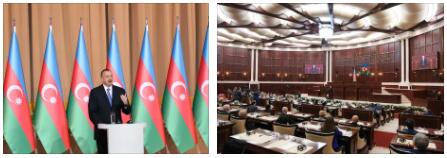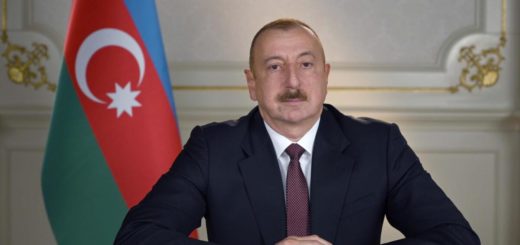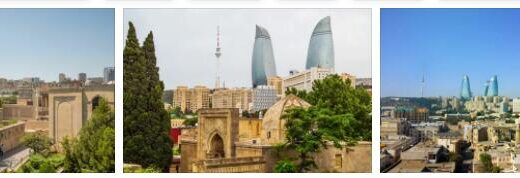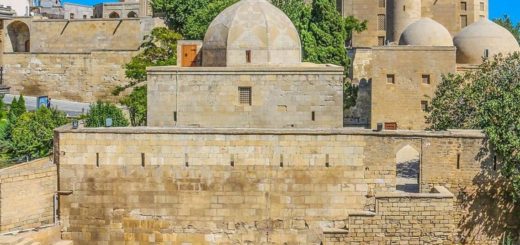History and Politics of Azerbaijan
History of Azerbaijan
The first states on the territory of Azerbaijan arose at the beginning of the 1st millennium BC. and were under Persian rule. Later, the territory of Azerbaijan was part of the Caucasian Albania tribal association, subordinated to the Sasanian Iran, then to the Arab Caliphate. From the 8th c. the process of Turkization began, the Azerbaijani language was formed. In the 15th century the Azerbaijani state of the Shirvanshahs was formed. In the 16th-18th centuries Azerbaijan was a field of confrontation between Turkey and Persia, to the middle. 18th century about 15 khanates were formed on his land. In the 1st third of the 19th century. they were annexed to Russia.
After the October Revolution in Russia, Soviet power was established in Baku on November 15, 1917, but on May 28, 1918, the Azerbaijan National Council proclaimed the Republic of Azerbaijan, which was immediately occupied by Turkey, then by Great Britain, which withdrew its troops only in August 1919.
The Soviet period of Azerbaijan began on April 28, 1920, when the Red Army entered its territory. After the declaration of independence of Azerbaijan on August 30, 1991, Ayaz Mutalibov was elected president, who was forced to resign in March 1992 as a result of military failures in Nagorno-Karabakh. In June 1992, Abulfaz Elchibey, the leader of the Popular Front of Azerbaijan, was elected president, who also suffered military setbacks. In the conditions of the aggravated domestic political situation, the economic situation became more complicated. In June 1993, Elchibey fled Baku in connection with a military rebellion against him. Power passed to Heydar Aliyev, who led the Azerbaijan SSR from 1969–82 as First Secretary of the Central Committee. In October 1993 he was elected president. In October 1998, Aliyev was re-elected as head of state.
State structure and political system of Azerbaijan
Azerbaijan is a democratic legal state with a republican form of government. The 1995 Constitution is in force. Check equzhou for political system of Azerbaijan.
Administrative division of Azerbaijan: 59 regions, Nakhichevan Autonomous Republic. The issue of Nagorno-Karabakh, around which a long-term conflict continues, has not been resolved. The total number of cities is 69, of which 11 are cities of republican subordination, the largest are Baku, Ganja (294.7 thousand people), Sumgayit (279.2 thousand people), Mingechaur, Ali-Bayramli, Nakhichevan, Lankaran.
The highest legislative body is the parliament (Milli Mejlis), consisting of 125 deputies and elected for a term of 5 years on the basis of majoritarian and proportional electoral systems and universal, equal and direct elections by free, personal and secret ballot. The Parliament of Azerbaijan holds two sessions annually. Spring session – from February 1 to May 31, autumn – from September 30 to December 30.
The supreme body of executive power is the cabinet of ministers, appointed by the president and approved by the Milli Majlis.
The head of state is the president, the post of president was introduced in 1991. The president is elected in general elections by secret ballot for a term of 5 years, but no more than two terms.
In 2002, more than 30 parties were active. Since 1995, the New Azerbaijan Party under the leadership of G. Aliyev has become the leading political force. She holds the majority of seats in parliament. The leading opposition force in parliament is the Popular Front of Azerbaijan (the party of former President Elchibey). Of the other opposition parties, Musavat (Equality) and the National Independence Party are represented in parliament. Among the influential political organizations are the Azerbaijan Social Democratic Party and the Azerbaijan People’s Party.
Organizations of national minorities stand out among the public organizations of Azerbaijan. The most authoritative organization of the Russian diaspora is the Russian Community, headed by M. Zabelin. The National Council of Youth Organizations operates, in which 46 youth public organizations are represented (among them organizations of volunteers, disabled people, veterans of the Karabakh war, etc.). Check homeagerly for democracy and human rights of Azerbaijan.
The internal policy of the top leadership of Azerbaijan was aimed at ending hostilities between Azerbaijan and Armenia in Nagorno-Karabakh and eliminating the economic consequences of this war. One of the main tasks was the reconstruction and reform of the national economy, raising the living standards of the population.
The unresolved international issues include the mentioned problem of Nagorno-Karabakh and the unresolved by 2003 issue of the borders between Azerbaijan, the Russian Federation, Kazakhstan, Turkmenistan and Iran in the Caspian Sea.
There is universal military duty in Azerbaijan. Service life (for 2000) – 17 months – can be slightly increased in the Ground Forces. The armed forces include the Ground Forces (numbering 55.6 thousand people), the Navy (2.2 thousand people), the Air Force and Air Defense Forces (8.1 thousand people) and the border troops, organizationally included in composition of the Ministry of Internal Affairs (approximately 5 thousand people) (2000). In order to expand the training of higher national military personnel and specialists in the field of military sciences, the Academy of the Armed Forces has been established in Azerbaijan. Azerbaijan’s military spending is estimated at 30-40 billion manats. Department of Defense Budget $120 million (1999). Azerbaijan has diplomatic relations with the Russian Federation, established on April 3, 1992.



